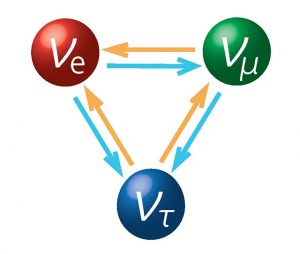Frequently Asked Questions
What are Neutrinos?

Neutrinos are tiny, almost massless particles, millions of which pass harmlessly through every one of us each second. Neutrinos were only postulated in the early 20th century as they very rarely interact and are therefore extremely difficult to detect, despite being the second most abundant particle in the universe.
These particles come in three flavours (that we know of so far!) and can change, “oscillate”, between these flavours. This was a very exciting discovery, as it meant we could conclusively deduce that neutrinos have mass, refuting their depiction in the Standard Model of Particle Physics. In fact, it was such an important discovery that it was the subject of the 2015 Nobel Prize in Physics.
What Do “Neutrino Oscillations” Entail?
“Neutrino Oscillation” is the phenomenon by which the neutrino flavours – known as electron, muon, and tau neutrinos – can change into each other. We now know that each flavour has a different mass since detecting these oscillations means that at least two neutrino flavours must have a non-zero mass.
One way of detecting neutrino oscillations is by creating a beam of neutrinos, measuring the flavour composition near the start of the beam, then again after it has travelled a known distance and quantifying differences. The beam used at DUNE will travel 1300 km between the near and the far detectors, through solid ground, which is plenty of room for the neutrinos to oscillate.
How Do You Create Neutrinos?
Neutrinos are all around in nature, produced by the Sun, supernovae, the atmosphere, the Big Bang, and even the Earth itself. They can also come from human-made sources: nuclear reactors, colliders, and accelerators. DUNE will use a particle accelerator called PIP-II.
PIP-II creates the neutrinos by accelerating protons using very strong magnets and electric fields, before hurling them into a solid target. There they collide with atoms in the materials to produce daughter particles, which can then participate in decays to form the neutrino beam in the direction of the detectors.
How Can You See The Neutrinos?
We actually can’t see the neutrinos themselves! What we can do though is look at the evidence for them, such as particles resulting from their interactions, and then infer the presence of a neutrino from detecting those instead. Many of our scientists work on “pattern recognition software” which allows us to put together a picture of the full interaction from what we can see.
As neutrinos interact very rarely, neutrino detectors are often very big in order to maximise the rate of detection. The detectors at DUNE will be huge, bigger than a house, and still see only a handful of neutrinos each day.
Who Works at DUNE?
The DUNE Collaboration consists of almost two thousand scientists from many countries, but the range of people needed to run the experiment extends well beyond just that. We need physicists to create the experiment, engineers and technicians to design and build it, media teams to make sure everyone gets to know about the work we’re doing, and support staff to make sure we have nice buildings to work in and food to eat while we work.
Is This Experiment Just Like the LHC at CERN?
No! Although both of these are high-energy particle physics experiments, they have different experimental setups and goals. The LHC looks at the collisions of hadrons, which are not fundamental particles, whereas DUNE looks at the properties of neutrinos. DUNE also relies on the beam from an accelerator, whereas the LHC is a collider experiment.
Why Should I Care About Neutrinos?
Neutrinos are one of the universe’s fundamental particles, with less than 100 years of research having been completed on them. Studying them will provide us with information as to why the universe is made of matter (and not antimatter), how black holes are created, and how these particles manage to change their flavour while travelling.
This research can also be applied to many practical applications, and we are certain more will be found as we come to understand this particle better. Nuclear reactors and nuclear weapons testing produce neutrinos as a byproduct, allowing neutrino detectors to discover unauthorised instances of these. There has also been some research into using them for fast, long-distance communications as they move very quickly and can travel straight through matter reliably. This is of course in addition to all the innovative technology (both hardware and software) produced in academia that will undoubtedly be applied to industry – don’t forget, the internet was created at the particle physics research laboratory CERN!